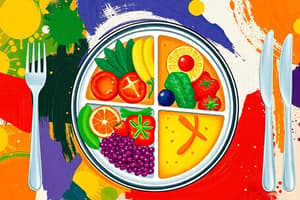Podcast
Questions and Answers
An individual is looking to increase their intake of water-insoluble fiber. Which of the following food components would be the MOST beneficial to incorporate into their diet?
An individual is looking to increase their intake of water-insoluble fiber. Which of the following food components would be the MOST beneficial to incorporate into their diet?
- Pectin
- Mucilage
- Cellulose (correct)
- Psyllium
Which of the following is a potential health consequence associated with excessive alcohol consumption?
Which of the following is a potential health consequence associated with excessive alcohol consumption?
- Elevated blood pressure (correct)
- Improved muscle strength
- Reduced risk of cancer
- Increased bone density
Which process BEST describes what occurs when grains are refined?
Which process BEST describes what occurs when grains are refined?
- The grain becomes a good source of water-insoluble fiber.
- The fiber content is significantly increased.
- The nutrients become more concentrated
- The bran and germ are removed. (correct)
After a starchy meal, pancreatic amylase aids in the breakdown of starches into which of the following?
After a starchy meal, pancreatic amylase aids in the breakdown of starches into which of the following?
If an individual consumes a food item containing lactose, they are consuming which combination of monosaccharides?
If an individual consumes a food item containing lactose, they are consuming which combination of monosaccharides?
If the pancreas were unable to produce bicarbonate, what direct effect would this have on digestion in the small intestine?
If the pancreas were unable to produce bicarbonate, what direct effect would this have on digestion in the small intestine?
A patient is experiencing difficulty digesting fats. Which of the following scenarios would most likely be the cause?
A patient is experiencing difficulty digesting fats. Which of the following scenarios would most likely be the cause?
How would the consumption of a large quantity of alcohol most likely affect the liver's ability to process fats?
How would the consumption of a large quantity of alcohol most likely affect the liver's ability to process fats?
If someone has consumed a toxic amount of alcohol, which organ is primarily responsible for detoxifying the alcohol to remove it from the bloodstream?
If someone has consumed a toxic amount of alcohol, which organ is primarily responsible for detoxifying the alcohol to remove it from the bloodstream?
How does alcohol consumption affect nerve signal transmission in the body?
How does alcohol consumption affect nerve signal transmission in the body?
Which study design is MOST suitable for observing the long-term effects of a dietary intervention on a group of individuals?
Which study design is MOST suitable for observing the long-term effects of a dietary intervention on a group of individuals?
A client is advised to follow the AMDR guidelines. If the client consumes 2000 calories per day, what is the acceptable range of calories they should consume from fat?
A client is advised to follow the AMDR guidelines. If the client consumes 2000 calories per day, what is the acceptable range of calories they should consume from fat?
Which of the following is NOT a primary consideration when establishing Dietary Reference Intakes (DRIs)?
Which of the following is NOT a primary consideration when establishing Dietary Reference Intakes (DRIs)?
A patient reports their food intake over the last 24 hours to a Registered Dietitian. Which method of dietary assessment is being used?
A patient reports their food intake over the last 24 hours to a Registered Dietitian. Which method of dietary assessment is being used?
Why is the term 'Registered Dietitian' regulated by law?
Why is the term 'Registered Dietitian' regulated by law?
A nutrition label is MOST likely to be required to display the amounts of which set of micronutrients?
A nutrition label is MOST likely to be required to display the amounts of which set of micronutrients?
Increasing dietary intake of calcium and vitamin D is MOST likely to reduce the risk of what condition?
Increasing dietary intake of calcium and vitamin D is MOST likely to reduce the risk of what condition?
What is the primary distinction between Type 1 and Type 2 diabetes concerning insulin production and cellular response?
What is the primary distinction between Type 1 and Type 2 diabetes concerning insulin production and cellular response?
Which list contains only essential amino acids?
Which list contains only essential amino acids?
Which factor does NOT directly influence the postprandial blood glucose response following carbohydrate consumption?
Which factor does NOT directly influence the postprandial blood glucose response following carbohydrate consumption?
Besides hyperglycemia, what are potential long-term health risks associated with Type 2 Diabetes?
Besides hyperglycemia, what are potential long-term health risks associated with Type 2 Diabetes?
How does lactose intolerance differ fundamentally from a milk allergy?
How does lactose intolerance differ fundamentally from a milk allergy?
If a person wants to reduce their sugar intake, which of the following would be the LEAST useful to consider?
If a person wants to reduce their sugar intake, which of the following would be the LEAST useful to consider?
How does consuming a diet rich in fruits and vegetables primarily contribute to reducing cancer risk?
How does consuming a diet rich in fruits and vegetables primarily contribute to reducing cancer risk?
Why is a diet low in fermentable carbohydrates recommended for reducing dental caries?
Why is a diet low in fermentable carbohydrates recommended for reducing dental caries?
Which of the following best describes the primary function of bile in the digestive process?
Which of the following best describes the primary function of bile in the digestive process?
How does the sympathetic nervous system influence digestion during a 'fight or flight' response?
How does the sympathetic nervous system influence digestion during a 'fight or flight' response?
Which of the following foods is the best source of lignans, a type of phytochemical?
Which of the following foods is the best source of lignans, a type of phytochemical?
Which of the following is the most accurate description of how water-soluble nutrients are transported after absorption in the small intestine?
Which of the following is the most accurate description of how water-soluble nutrients are transported after absorption in the small intestine?
What is a key characteristic of functional foods that differentiates them from other foods?
What is a key characteristic of functional foods that differentiates them from other foods?
What effect do phytoestrogens have that may help in osteoporosis prevention?
What effect do phytoestrogens have that may help in osteoporosis prevention?
Flashcards
Essential Amino Acids
Essential Amino Acids
Eight amino acids that the body cannot synthesize and must be obtained from diet.
Essential Fatty Acids
Essential Fatty Acids
Fatty acids necessary for health; includes linoleic acid and linolenic acid.
AMDR
AMDR
Acceptable Macronutrient Distribution Range indicating percentage of carbs, fats, and proteins recommended in the diet.
RDA
RDA
Signup and view all the flashcards
Diet Recall vs Record
Diet Recall vs Record
Signup and view all the flashcards
Epidemiological Studies
Epidemiological Studies
Signup and view all the flashcards
Intervention Studies
Intervention Studies
Signup and view all the flashcards
Nutritional Labelling
Nutritional Labelling
Signup and view all the flashcards
Heart Disease Prevention
Heart Disease Prevention
Signup and view all the flashcards
Cancer Prevention
Cancer Prevention
Signup and view all the flashcards
Dental Health
Dental Health
Signup and view all the flashcards
Phytochemicals
Phytochemicals
Signup and view all the flashcards
Functional Foods
Functional Foods
Signup and view all the flashcards
Nutrient Absorption
Nutrient Absorption
Signup and view all the flashcards
Nutrient Transport: Water-soluble
Nutrient Transport: Water-soluble
Signup and view all the flashcards
Nutrient Transport: Fat-soluble
Nutrient Transport: Fat-soluble
Signup and view all the flashcards
Hydrochloric Acid
Hydrochloric Acid
Signup and view all the flashcards
Pepsin
Pepsin
Signup and view all the flashcards
Pancreatic Amylase
Pancreatic Amylase
Signup and view all the flashcards
Alcohol Metabolism Location
Alcohol Metabolism Location
Signup and view all the flashcards
MEOS
MEOS
Signup and view all the flashcards
Type 1 Diabetes
Type 1 Diabetes
Signup and view all the flashcards
Type 2 Diabetes
Type 2 Diabetes
Signup and view all the flashcards
Postprandial CHO Digestion
Postprandial CHO Digestion
Signup and view all the flashcards
Sugar Alcohols
Sugar Alcohols
Signup and view all the flashcards
Lactose Intolerance vs Milk Allergy
Lactose Intolerance vs Milk Allergy
Signup and view all the flashcards
Alcohol health risks
Alcohol health risks
Signup and view all the flashcards
Wheat Kernel parts
Wheat Kernel parts
Signup and view all the flashcards
Monosaccharides
Monosaccharides
Signup and view all the flashcards
Disaccharides
Disaccharides
Signup and view all the flashcards
Water soluble fiber
Water soluble fiber
Signup and view all the flashcards
Study Notes
8 Essential Amino Acids
- Threonine, valine, tryptophan, isoleucine, leucine, lysine, phenylalanine, methionine
2 Essential Fatty Acids
- Linoleic acid and linolenic acid
Essential Vitamins
- Fat-soluble (A, D, E, K) and water-soluble
Epidemiological Studies
- Large-scale comparisons between populations
Intervention Studies
- Manipulating populations
Longitudinal Studies
- Research that follows and retests the same people over time
Registered Dietitian Requirements
- Term regulated by law
- Member of provincial regulatory board
- Optional: Membership with Dieticians of Canada
- Undergraduate degree + internship
Diet Recall vs Record
- 24 hours, client may lie
- 3-5 days, recording may change eating habits
AMDR
- Acceptable Macronutrient Distribution Range
- CHO: 45-65%
- Fat: 20-35%
- Protein: 10-35%
RDA
- Recommended Dietary Allowance: intake goals
EAR
- Estimated Average Requirement: average intake based on life stages
AI
- Adequate Intake
UL
- Tolerable Upper Intake Level
Factors Not Considered in DRI
- Activity level
- Diet type
- Geography/socioeconomic/cultural
- Illness/disease states
Factors Considered in DRI
- BMI
- Age
Nutritional Labelling Micronutrient Requirements
- Sodium, calcium, iron, potassium
Benefit of a Diet Low in Sodium and High in Potassium
- Less hypertension
Benefit of Calcium and Vitamin D in the Diet
- Less osteoporosis
Benefit of a Diet Low in Saturated and Trans Fats
- Less heart disease
Benefit of a Diet High in Fruits and Vegetables
- Less cancer
Benefit of a Diet Low in Fermentable Carbohydrates
- Less dental caries
Phytochemicals
- Natural plant compounds with potential health benefits
Phytochemical Found in Tomatoes
- Lycopene
Phytochemical Found in Garlic
- Organosulfur
Phytochemical Found in Flaxseeds
- Lignans
Role of Flavonoids in Health
- Antioxidants
Foods Rich in Flavonoids
- Soy, wine, tea, chocolate
Health Benefit of Phytoestrogens
- Osteoporosis prevention
Functional Foods
- Contain biologically active compounds
- Benefits beyond basic nutrition
Parasympathetic Nervous System (Digestion)
- Regulates digestion via gastric juices
Sympathetic Nervous System
- Stress, "fight or flight"
Bile
- Cholesterol-containing digestive fluid that emulsifies fat
- Made by the liver, stored in the gallbladder, released in the small intestine
Nutrient Absorption
- Movement of nutrients from the small intestine into the blood or lymph via villi and microvilli
Nutrient Transport for Water-Soluble Nutrients
- Via blood; small intestine -> processed in liver -> liver distributes to the rest of the body
Nutrient Transport for Fat-Soluble Nutrients
- Via lymphatic system; small intestine -> lymph system
Stomach Chemical Digestion
- Gastric juices (hydrochloric acid (HCl) and pepsin, etc.)
- Hydrochloric acid: strong acid/low pH
- Pepsin: enzyme to break down protein
Small Intestine in Digestion
- Pancreas (Bicarbonate neutralizes acid. Enzymes to break down CHO, protein, and fat)
- Liver and gallbladder (bile emulsifies fat)
Enzyme for Carbohydrate Digestion (Pancreas)
- Pancreatic amylase
Enzyme for Fat Digestion (Pancreas)
- Pancreatic lipase
Enzyme for Protein Digestion (Pancreas)
- Trypsin and chymotrypsin
Liver and Gallbladder Function
- Creation and storage of bile (emulsifies fat in small intestine)
GERD
- Gastroesophageal reflux disease
Nutrient Storage Systems
- Fat: adipose tissue
- CHO: glycogen in liver and muscles
- Minerals: bones (calcium, phosphorus)
Alcohol Consideration
- Depressant
Alcohol Absorption
- Stomach and small intestine (80%)
Alcohol Metabolism Location
- Liver (80% via alcohol dehydrogenase (ADH)), 10% MEOS
MEOS
- Microsomal ethanol-oxidizing system (chain of enzymes that break down alcohol).
Alcohol's Effects on Bodily Functions
- Slows nerve signals
- Judgement
- Muscle control
- Heart and Breathing
Alcohol's Effects on Cells
- Dissolves lipids, penetrates cell's membranes readily
- Denatures cell proteins
- Fat accumulation in liver
Alcohol Increases Risk Of
- High blood pressure
- Dementia
- Mouth, liver, breast cancers
- Muscle deterioration
- Thiamin deficiency (Wernicke-Korsakoff syndrome)
Wheat Kernel
- 4 Parts (Germ, endosperm, bran, husk).
Refined
- Removal of bran, germ
Monosaccharides
- Glucose, fructose, galactose
Disaccharides
- Sucrose (fructose + glucose), lactose (galactose + glucose), maltose (glucose + glucose)
DRI Recommendation for Fiber
- 25g
DRI Recommendation for Sugar
- Less than 25% of calories from sugar
Starch
- Storage of glucose in plants (branched or unbranched), insoluble
Water Soluble Fiber Includes
- Gums, mucilage, pectin, psyllium, some hemicellulose
Water Soluble Fiber Aids In
- Lowering blood cholesterol
- Slowing glucose absorption
- Reducing heart and diabetes risk
Water Insoluble Fiber Includes
- Cellulose, lignin, some hemicellulose
Water Insoluble Fiber Aids In
- Increasing bulk
- Reducing diverticular disease, hemorrhoids, appendicitis
Small Intestine in CHO Digestion
- Enzymes (disaccharides -> monosaccharides)
- Pancreatic amylase (starches -> disaccharides)
- Monosaccharides -> liver -> glucose
CHO Digestion/Glucose Conversion Occurs In
- Small intestine (monosaccharides are converted to glucose)
Type 1 vs Type 2 Diabetes
- Type 1: autoimmune destruction of insulin-producing cells (little to no insulin produced)
- Type 2: cells become resistant to insulin (90% of cases)
Postprandial CHO Digestion
- Blood sugar increases after consumption
- Amount of increase reflects consumed amount, rate of digestion, glucose entry into blood stream, and glucose uptake rates by body cells.
Type 2 Diabetes Increases Risk Of
- Cardiovascular disease
- Kidney disease
Sugar Alcohols
- Sorbitol, xylitol, malitol
Artificial Sweeteners
- Aspartame, sucralose, acesulfame-k
Lactose Intolerance vs Milk Allergy
- Lactose intolerance: lack of lactase enzyme;
- Milk allergy: immune response to milk protein
Studying That Suits You
Use AI to generate personalized quizzes and flashcards to suit your learning preferences.




